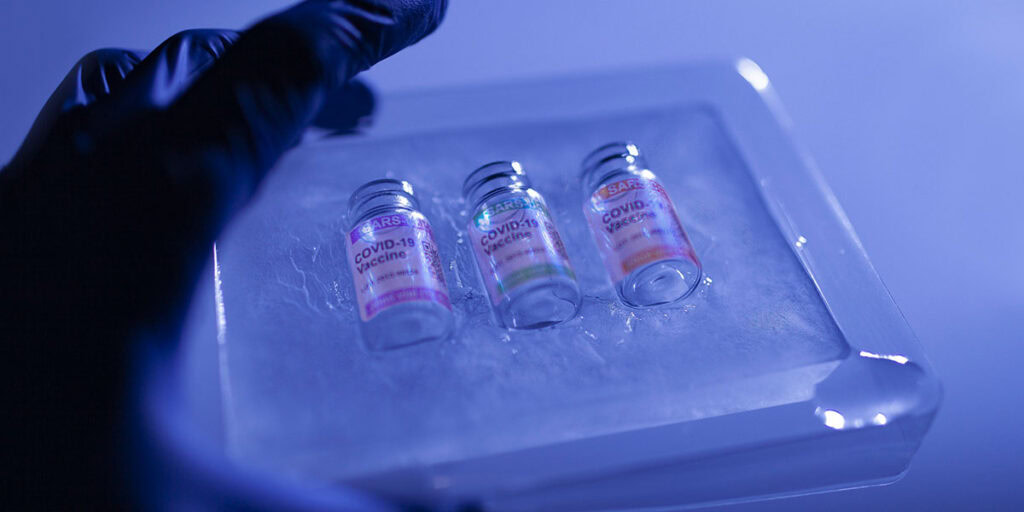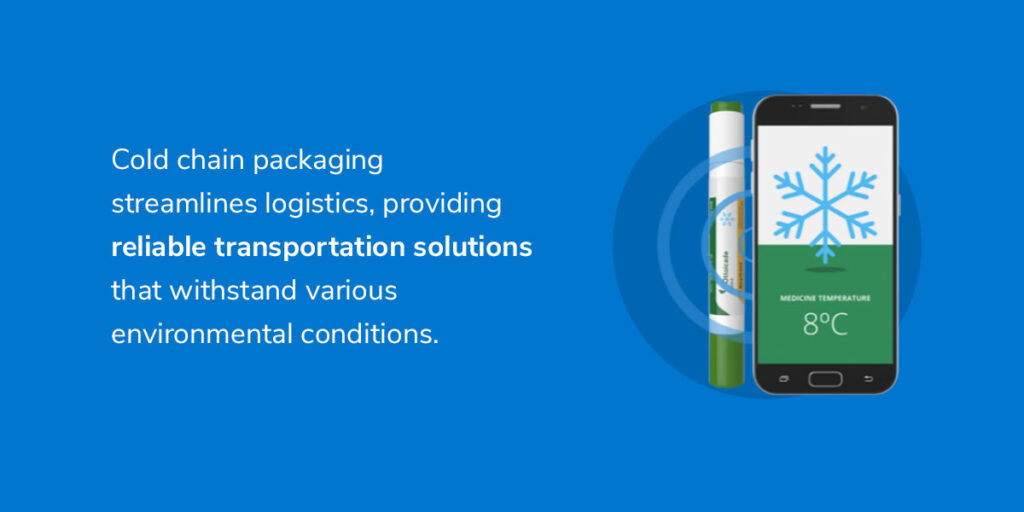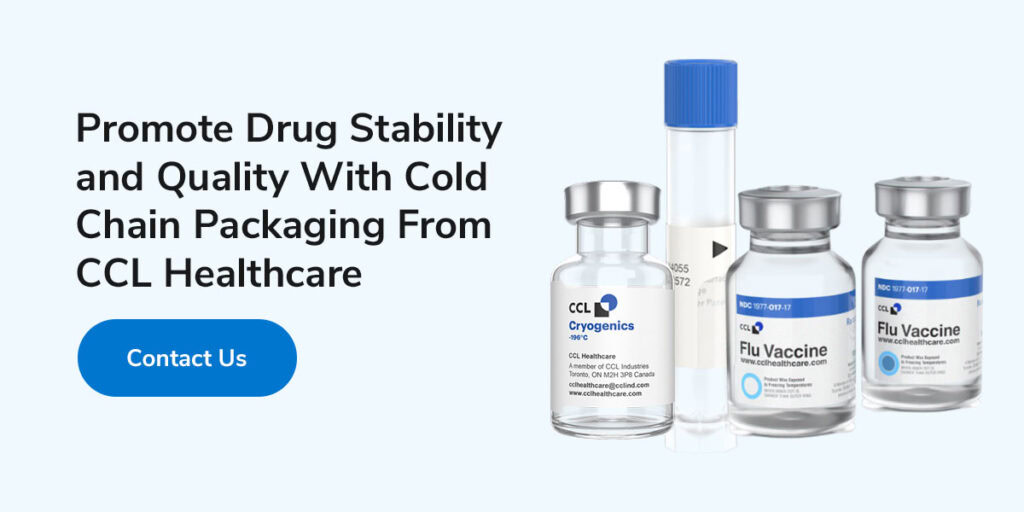Cold Chain Packaging:
Ensuring Drug Stability and Quality During Transit

Pharmaceutical supply chain management is a complex and detailed process. Many drugs are sensitive to temperature fluctuations and will be rendered unusable without practical storage and transportation. Cold chain packaging provides an actionable solution to temperature-related challenges. It maintains predetermined temperature ranges and ensures drugs remain safe and effective.
The global cold chain packaging market will likely reach $103.7 billion by 2033 as more organizations leverage its cost-saving and quality assurance benefits. Much of the pharmaceutical industry already uses cold chain packaging to maintain temperature-sensitive medications. Understanding what cold chain packaging is and how it works is essential for anyone operating in this evolving market.
What Is Pharmaceutical Cold Chain Packaging?
Cold chain packaging is a type of temperature packing system (TPS) designed to maintain a consistent temperature around pharmaceuticals during transportation. It forms a critical part of the pharmaceutical cold chain — a niche set of operating procedures that dictates the transportation of temperature-sensitive products. In short, it’s a type of packaging that ensures an unbroken chain of temperature-controlled environments that take medications from manufacturing to administration.
The primary components of cold chain packaging include:
- Insulated containers: These containers store and preserve products that require a specific maintenance temperature during transportation. They protect the medications inside from external temperature fluctuations. Many types of cold chain packaging exist, and the choice depends on the medication and laboratory applications.
- Refrigerants: Cold chain refrigerants stabilize the packaging’s internal temperature. They often take the form of ice packs, gel pads or phase-change materials (PCMs). They are packaged within insulated containers and may guarantee protection at specific temperatures depending on the specimen’s required payload temperature.
- Temperature monitoring devices: Temperature fluctuations can damage pharmaceuticals, rendering them unusable. These fluctuations must be monitored to establish traceability and promote patient safety. Real-time monitoring systems offer this traceability when in transit, providing immediate notification of temperature changes. Sometimes, cold chain temperature indicators can show when the threshold temperature is exceeded, excluding any medications transported in unsuitable temperatures.
The Benefits of Cold Chain Packaging in Pharmaceutical Applications
Cold chain packaging and storage allow sensitive drugs to be transported over long distances while maintaining stability and addressing vaccination transport challenges, among other things. Some of the many advantages of cold chain packaging include:

- Drug integrity and quality: The cold chain packaging process protects sensitive products from degradation, ensuring they remain safe and effective for patient use.
- Traceability and monitoring: Cold chain packaging often includes tracking and monitoring systems to provide real-time temperature updates, which offer additional transparency and accountability.
- Extended shelf life: Cold chain packaging and storage enables longer storage times for temperature-sensitive medications, reducing waste and improving inventory management.
- Improved patient safety: When medication is stored and transported in optimal conditions, the potential health risks of temperature fluctuations are minimized. Over time, these processes build trust with healthcare providers and patients.
- Cost savings: Although it may represent a higher upfront investment, cold chain packaging can reduce product spoilage and recall losses.
- Enhanced supply chain efficiency: Cold chain packaging streamlines logistics, providing reliable transportation solutions that withstand various environmental conditions.
Challenges and Risk Management in Cold Chain Logistics
Many factors can cause temperature fluctuations in the pharmaceutical supply chain, from subpar storage conditions and shipping delays to human error. Improper storage conditions and inadequate temperature can significantly impact medication quality, safety and effectiveness. Shipping delays and other logistical issues can also expose sensitive products to unfavorable conditions. Human error in handling or monitoring mistakes presents another considerable risk.
These risks are significant, and effective risk management begins with sound packaging design and qualification testing. When packaging design is tailored to the product’s unique requirements, it becomes an effective barrier against suboptimal temperatures, regardless of the cause. Cold chain packaging can mitigate risks across the supply chain, withstanding various environmental stressors, including temperature fluctuations.
Regulatory Compliance
Stringent regulations challenge the traditional supply chain, and the cold supply chain compounds these compliance challenges. Carriers must maintain detailed temperature control logs, sometimes hourly, to maintain compliance. The carrier may be subject to significant fines or license suspension if these logs are neglected or filled incorrectly.
Many organizations seek internationally recognized certifications to verify compliance with existing cold chain standards. ISO 9001, for example, confirms compliance with stringent quality control guidelines. The pharmaceutical industry also has certifications, including the Good Distribution Practice (GDP).
Types of Cold Chain Packaging Materials
Several components and materials exist within cold chain packaging to ensure maximum temperature control for different products and environments. Some common packaging materials include:
- Insulated shippers: These containers are made from materials with superior insulative properties. They provide thermal protection by reducing heat transfer and minimizing the effects of temperature fluctuations.
- Dry ice: Dry ice is made from solid carbon dioxide (CO2) and is a popular refrigerant in cold chain packaging. Its substantial cooling properties make it ideal for maintaining low temperatures.
- Vacuum-insulated panels (VIPs): These panels have a vacuum-sealed core to minimize heat transfer. Their excellent insulation properties make them popular in manufacturing cold chain packaging.
- Ice and gel packs: These materials are popular in cold chain packaging for additional cooling. They are frozen and placed inside the packaging to help maintain optimal temperatures for longer.
- PCMs: These substances can absorb or release thermal energy as they change from liquid to solid. They can be incorporated into the packaging to maintain consistent temperatures. They can also absorb and release heat when temperatures drop, helping regulate the packaging environment.
- Temperature-controlled packaging systems: These advanced systems incorporate technology like temperature sensors to work off temperature data and make real-time adjustments. They actively monitor and regulate the temperature within the packaging to maintain the desired temperature ranges.
Sustainability in Cold Chain Packaging
A principal benefit of cold chain packaging is that it creates the opportunity to integrate sustainable materials throughout the supply chain. A massive 90% of executives feel that sustainability is essential. As global trends focus on eco-friendly practices, they will likely choose to work with organizations that share the same values.
Cold chain packaging is already designed to maintain the same product quality while using eco-friendly materials. Pharmaceutical organizations can forge new business partnerships and boost their sustainability profiles with the right combination of technology and materials.
Why Trust CCL Healthcare?
CCL Healthcare is partnered globally, printing locally. As a global leader in the healthcare packaging industry with over 65 years of experience, we are a trusted partner for many worldwide healthcare businesses. Our customized solutions are tailored to meet our clients’ unique needs.
We operate over 34 dedicated current good manufacturing practice (cGMP) healthcare facilities worldwide. Our global reach enables us to meet your needs, regardless of location. Our strict process controls and quality systems ensure the highest product quality and consistency.
Our team of experts is one of the many reasons we’re a trusted healthcare partner. Our combined technical expertise, passion for innovation and commitment to sustainability uniquely positions us to support our clients throughout the product life cycle. Our innovative packaging solutions continue to protect our clients’ brands, making us the manufacturer of choice for pharmaceutical organizations worldwide.
Promote Drug Stability and Quality With Cold Chain Packaging From CCL Healthcare
Drug stability and quality are essential for pharmaceutical organizations, carriers and patients. Innovative cold chain packaging can reduce waste, save money and ensure patient safety. CCL Healthcare can support you throughout the supply chain by providing state-of-the-art packaging solutions tailored to your unique needs. Contact us for more information today!
